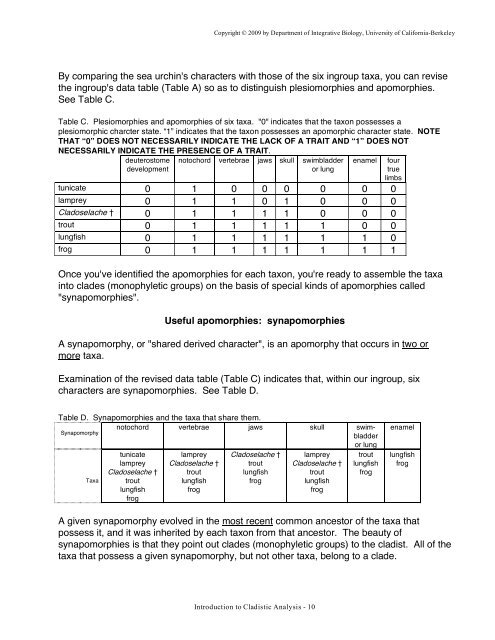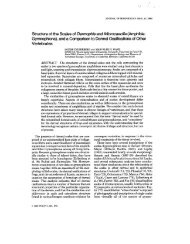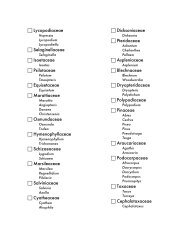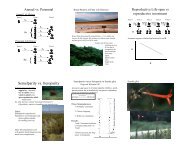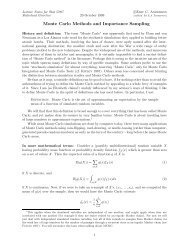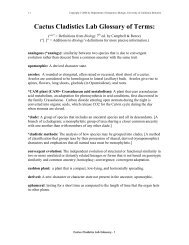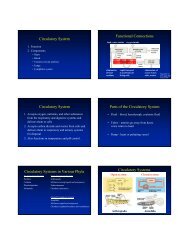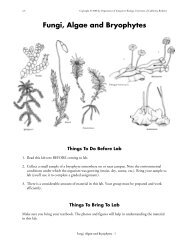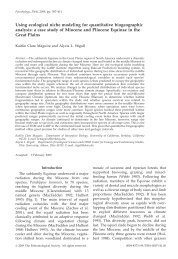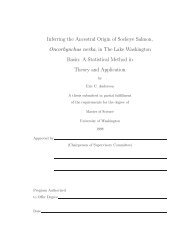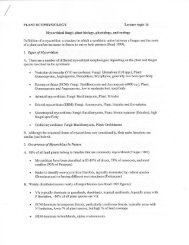Introduction to Cladistic Analysis - Integrative Biology - University of ...
Introduction to Cladistic Analysis - Integrative Biology - University of ...
Introduction to Cladistic Analysis - Integrative Biology - University of ...
You also want an ePaper? Increase the reach of your titles
YUMPU automatically turns print PDFs into web optimized ePapers that Google loves.
Copyright © 2009 by Department <strong>of</strong> <strong>Integrative</strong> <strong>Biology</strong>, <strong>University</strong> <strong>of</strong> California-Berkeley<br />
By comparing the sea urchin's characters with those <strong>of</strong> the six ingroup taxa, you can revise<br />
the ingroup's data table (Table A) so as <strong>to</strong> distinguish plesiomorphies and apomorphies.<br />
See Table C.<br />
Table C. Plesiomorphies and apomorphies <strong>of</strong> six taxa. "0" indicates that the taxon possesses a<br />
plesiomorphic charcter state. “1” indicates that the taxon possesses an apomorphic character state. NOTE<br />
THAT “0” DOES NOT NECESSARILY INDICATE THE LACK OF A TRAIT AND “1” DOES NOT<br />
NECESSARILY INDICATE THE PRESENCE OF A TRAIT.<br />
deuteros<strong>to</strong>me<br />
development<br />
no<strong>to</strong>chord vertebrae jaws skull swimbladder<br />
or lung<br />
Once you've identified the apomorphies for each taxon, you're ready <strong>to</strong> assemble the taxa<br />
in<strong>to</strong> clades (monophyletic groups) on the basis <strong>of</strong> special kinds <strong>of</strong> apomorphies called<br />
"synapomorphies".<br />
Useful apomorphies: synapomorphies<br />
A synapomorphy, or "shared derived character", is an apomorphy that occurs in two or<br />
more taxa.<br />
Examination <strong>of</strong> the revised data table (Table C) indicates that, within our ingroup, six<br />
characters are synapomorphies. See Table D.<br />
Table D. Synapomorphies and the taxa that share them.<br />
Synapomorphy<br />
no<strong>to</strong>chord vertebrae jaws skull swimbladder<br />
or lung<br />
tunicate lamprey Cladoselache † lamprey trout<br />
lamprey Cladoselache † trout Cladoselache † lungfish<br />
Cladoselache † trout<br />
lungfish<br />
trout frog<br />
Taxa trout<br />
lungfish<br />
frog<br />
lungfish<br />
lungfish<br />
frog<br />
frog<br />
frog<br />
<strong>Introduction</strong> <strong>to</strong> <strong>Cladistic</strong> <strong>Analysis</strong> - 10<br />
enamel four<br />
true<br />
limbs<br />
tunicate 0 1 0 0 0 0 0 0<br />
lamprey 0 1 1 0 1 0 0 0<br />
Cladoselache † 0 1 1 1 1 0 0 0<br />
trout 0 1 1 1 1 1 0 0<br />
lungfish 0 1 1 1 1 1 1 0<br />
frog 0 1 1 1 1 1 1 1<br />
enamel<br />
lungfish<br />
frog<br />
A given synapomorphy evolved in the most recent common ances<strong>to</strong>r <strong>of</strong> the taxa that<br />
possess it, and it was inherited by each taxon from that ances<strong>to</strong>r. The beauty <strong>of</strong><br />
synapomorphies is that they point out clades (monophyletic groups) <strong>to</strong> the cladist. All <strong>of</strong> the<br />
taxa that possess a given synapomorphy, but not other taxa, belong <strong>to</strong> a clade.


